Identifying Optimal Sites for a Rainwater-Harvesting Agricultural Scheme in Iran Using the Best-Worst Method and Fuzzy Logic in a GIS-Based Decision Support System
Abstract
1. Introduction
2. Methodology and Materials
2.1. Overview of the Study Area
2.2. System Description
2.3. Process of the Best-Worst Method (BWM) and Fuzzy Logic in Geographic Information System (GIS)
2.4. Dataset and Data Processing
2.4.1. Rainfall Data
2.4.2. Spatial Geographic Information
2.5. Setting Criteria for Multiple Criteria Decision Making (MCDM)
2.6. Types of Rainwater-Harvesting (RWH) Techniques
2.6.1. Ponds and Pans
2.6.2. Check Dams
2.6.3. Percolation Tanks
3. Results and Discussion
3.1. Results of Rainfall Analysis
3.2. Suitability Ranking for the Criteria
3.3. BWM Results and General Suitability Maps
3.4. Constraint Map
3.5. Identifying Suitable Areas for Different RWH Systems and Scenarios
3.6. Sensitivity Analysis Using the OAT Method
3.7. Strategy for the Development of RWH Agriculture
3.7.1. Phase One: Install RWH Systems in the Existing Farming Areas
3.7.2. Phase Two: Increase the Local Supply by Creating New Farmland
3.7.3. Phase Three: Develop Farmland for Commercial Exporting
4. Conclusions
Author Contributions
Funding
Conflicts of Interest
References
- Salameh, E. Over-exploitation of groundwater resources and their environmental and socio-economic implications: The case of Jordan. Water Int. 2008, 33, 55–68. [Google Scholar] [CrossRef]
- Chen, J.; Wu, H.; Qian, H.; Li, X. Challenges and prospects of sustainable groundwater management in an agricultural plain along the Silk Road Economic Belt, north-west China. Int. J. Water Resour. Dev. 2018, 34, 354–368. [Google Scholar] [CrossRef]
- Alfarrah, N.; Walraevens, K. Groundwater overexploitation and seawater intrusion in coastal areas of arid and semi-arid regions. Water 2018, 10, 143. [Google Scholar] [CrossRef]
- Binyam, A.Y.; Desale, K.A. Rainwater harvesting: An option for dry land agriculture in arid and semi-arid Ethiopia. Int. J. Water Resour. Environ. Eng. 2015, 7, 17–28. [Google Scholar] [CrossRef]
- Kadam, A.K.; Kale, S.S.; Pande, N.N.; Pawar, N.J.; Sankhua, R.N. Identifying Potential Rainwater Harvesting Sites of a Semi-arid, Basaltic Region of Western India, Using SCS-CN Method. Water Resour. Manag. 2012, 26, 2537–2554. [Google Scholar] [CrossRef]
- Mesgaran, M.B.; Madani, K.; Hashemi, H.; Azadi, P. Iran’s Land Suitability for Agriculture. Sci. Rep. 2017, 7, 7670. [Google Scholar] [CrossRef] [PubMed]
- Mesgaran, M.B.; Azadi, P. A National Adaptation Plan for Water Scarcity in Iran; Stanford University: Stanford, CA, USA, 2018. [Google Scholar]
- Gohari, A.; Eslamian, S.; Mirchi, A.; Abedi-Koupaei, J.; Massah Bavani, A.; Madani, K. Water transfer as a solution to water shortage: A fix that can Backfire. J. Hydrol. 2013, 491, 23–39. [Google Scholar] [CrossRef]
- Nazari, B.; Liaghat, A.; Akbari, M.R.; Keshavarz, M. Irrigation water management in Iran: Implications for water use efficiency improvement. Agric. Water Manag. 2018, 208, 7–18. [Google Scholar] [CrossRef]
- Madani, K.; AghaKouchak, A.; Mirchi, A. Iran’s Socio-economic Drought: Challenges of a Water-Bankrupt Nation. Iran. Stud. 2016, 49, 997–1016. [Google Scholar] [CrossRef]
- Madani, K. The value of extreme events: What doesn’t exterminate your water system makes it more resilient. J. Hydrol. 2019, 575, 269–272. [Google Scholar] [CrossRef]
- Assefa, S.; Biazin, B.; Muluneh, A.; Yimer, F.; Haileslassie, A. Rainwater harvesting for supplemental irrigation of onions in the southern dry lands of Ethiopia. Agric. Water Manag. 2016, 178, 325–334. [Google Scholar] [CrossRef]
- Guarnieri, L.; Salman, M. Emerging practices from agricultural water management in Africa and the Near East. In Proceedings of the Thematic Workshop—CIHEAM Bari, Bari, Italy, 28–31 August 2017. [Google Scholar]
- Velasco-Muñoz, J.F.; Aznar-Sánchez, J.A.; Batlles-delaFuente, A.; Fidelibus, M.D. Rainwater Harvesting for Agricultural Irrigation: An Analysis of Global Research. Water 2019, 11, 1320. [Google Scholar] [CrossRef]
- Biazin, B.; Sterk, G.; Temesgen, M.; Abdulkedir, A.; Stroosnijder, L. Rainwater harvesting and management in rainfed agricultural systems in sub-Saharan Africa—A review. Phys. Chem. Earth Parts A/B/C 2012, 47–48, 139–151. [Google Scholar] [CrossRef]
- Tabatabaee, J.; Han, M.Y. Rainwater harvesting potentials for drought mitigation in Iran. Water Sci. Technol. 2010, 62, 816–821. [Google Scholar] [CrossRef] [PubMed]
- Fooladmand, H.R.; Sepaskhah, A.R. Economic analysis for the production of four grape cultivars using microcatchment water harvesting systems in Iran. J. Arid Environ. 2004, 58, 525–533. [Google Scholar] [CrossRef]
- Deng, X.P.; Shan, L.; Zhang, H.; Turner, N.C. Improving agricultural water use efficiency in arid and semiarid areas of China. Agric. Water Manag. 2006, 80, 23–40. [Google Scholar] [CrossRef]
- Mwenge Kahinda, J.; Rockström, J.; Taigbenu, A.; Dimes, J. Rainwater harvesting to enhance water productivity of rainfed agriculture in the semi-arid Zimbabwe. Phys. Chem. Earth Parts A/B/C 2007, 32, 1068–1073. [Google Scholar] [CrossRef]
- Li, X.-Y.; Gong, J.-D.; Wei, X. In-situ rainwater harvesting and gravel mulch combination for corn production in the dry semi-arid region of China. J. Arid Environ. 2000, 46, 371–382. [Google Scholar] [CrossRef]
- Schiettecatte, W.; Ouessar, M.; Gabriels, D.; Tanghe, S.; Heirman, S.; Abdelli, F. Impact of water harvesting techniques on soil and water conservation: A case study on a micro catchment in southeastern Tunisia. J. Arid Environ. 2005, 61, 297–313. [Google Scholar] [CrossRef]
- Christian Amos, C.; Rahman, A.; Mwangi Gathenya, J. Economic Analysis and Feasibility of Rainwater Harvesting Systems in Urban and Peri-Urban Environments: A Review of the Global Situation with a Special Focus on Australia and Kenya. Water 2016, 8, 149. [Google Scholar] [CrossRef]
- Nachshon, U.; Netzer, L.; Livshitz, Y. Land cover properties and rain water harvesting in urban environments. Sustain. Cities Soc. 2016, 27, 398–406. [Google Scholar] [CrossRef]
- Campisano, A.; Butler, D.; Ward, S.; Burns, M.J.; Friedler, E.; DeBusk, K.; Fisher-Jeffes, L.N.; Ghisi, E.; Rahman, A.; Furumai, H.; et al. Urban rainwater harvesting systems: Research, implementation and future perspectives. Water Res. 2017, 115, 195–209. [Google Scholar] [CrossRef]
- Gwenzi, W.; Dunjana, N.; Pisa, C.; Tauro, T.; Nyamadzawo, G. Water quality and public health risks associated with roof rainwater harvesting systems for potable supply: Review and perspectives. Sustain. Water Qual. Ecol. 2015, 6, 107–118. [Google Scholar] [CrossRef]
- Amos, C.C.; Rahman, A.; Karim, F.; Gathenya, J.M. A scoping review of roof harvested rainwater usage in urban agriculture: Australia and Kenya in focus. J. Clean. Prod. 2018, 202, 174–190. [Google Scholar] [CrossRef]
- Helmreich, B.; Horn, H. Opportunities in rainwater harvesting. Desalination 2009, 248, 118–124. [Google Scholar] [CrossRef]
- Adham, A.; Wesseling, J.G.; Riksen, M.; Ouessar, M.; Ritsema, C.J. A water harvesting model for optimizing rainwater harvesting in the wadi Oum Zessar watershed, Tunisia. Agric. Water Manag. 2016, 176, 191–202. [Google Scholar] [CrossRef]
- Mahmoud, S.H.; Alazba, A.A. The potential of in situ rainwater harvesting in arid regions: Developing a methodology to identify suitable areas using GIS-based decision support system. Arab. J. Geosci. 2015, 8, 5167–5179. [Google Scholar] [CrossRef]
- Adham, A.; Riksen, M.; Ouessar, M.; Ritsema, C. A Methodology to Assess and Evaluate Rainwater Harvesting Techniques in (Semi-) Arid Regions. Water 2016, 8, 198. [Google Scholar] [CrossRef]
- Ammar, A.; Riksen, M.; Ouessar, M.; Ritsema, C. Identification of suitable sites for rainwater harvesting structures in arid and semi-arid regions: A review. Int. Soil Water Conserv. Res. 2016, 4, 108–120. [Google Scholar] [CrossRef]
- Mahmoud, S.H.; Tang, X. Monitoring prospective sites for rainwater harvesting and stormwater management in the United Kingdom using a GIS-based decision support system. Environ. Earth Sci. 2015, 73, 8621–8638. [Google Scholar] [CrossRef]
- Krois, J.; Schulte, A. GIS-based multi-criteria evaluation to identify potential sites for soil and water conservation techniques in the Ronquillo watershed, northern Peru. Appl. Geogr. 2014, 51, 131–142. [Google Scholar] [CrossRef]
- Dewana, A.A. Suitable Site Selection for Rainwater Harvesting and Storage Case Study Using Dohuk Governorate. Water 2019, 11, 864. [Google Scholar]
- Mahmoud, S.H.; Alazba, A.A.; Adamowski, J.; El-Gindy, A.M. Rainwater harvesting for the management of agricultural droughts in arid and semi-arid regions. Paddy Water Environ. 2015, 14, 231–246. [Google Scholar] [CrossRef]
- Wu, R.-S.; Molina, G.L.L.; Hussain, F. Optimal Sites Identification for Rainwater Harvesting in Northeastern Guatemala by Analytical Hierarchy Process. Water Resour. Manag. 2018, 32, 4139–4153. [Google Scholar] [CrossRef]
- Shadmehri Toosi, A.; Ghasemi Tousi, E.; Ghassemi, S.A.; Cheshomi, A.; Alaghmand, S. A multi-criteria decision analysis approach towards efficient rainwater harvesting. J. Hydrol. 2020, 582, 124501. [Google Scholar] [CrossRef]
- Moslem, S.; Gul, M.; Farooq, D.; Celik, E.; Ghorbanzadeh, O.; Blaschke, T. An Integrated Approach of Best-Worst Method (BWM) and Triangular Fuzzy Sets for Evaluating Driver Behavior Factors Related to Road Safety. Mathematics 2020, 8, 414. [Google Scholar] [CrossRef]
- Rezaei, J. Best-worst multi-criteria decision-making method. Omega 2015, 53, 49–57. [Google Scholar] [CrossRef]
- Ren, J.; Liang, H.; Chan, F.T.S. Urban sewage sludge, sustainability, and transition for Eco-City: Multi-criteria sustainability assessment of technologies based on best-worst method. Technol. Forecast. Soc. Change 2017, 116, 29–39. [Google Scholar] [CrossRef]
- Rezaei, J.; Wang, J.; Tavasszy, L. Linking supplier development to supplier segmentation using Best Worst Method. Expert Syst. Appl. 2015, 42, 9152–9164. [Google Scholar] [CrossRef]
- Salimi, N.; Rezaei, J. Measuring efficiency of university-industry Ph.D. projects using best worst method. Scientometrics 2016, 109, 1911–1938. [Google Scholar] [CrossRef]
- Guo, S.; Zhao, H. Fuzzy best-worst multi-criteria decision-making method and its applications. Knowl. Based Syst. 2017, 121, 23–31. [Google Scholar] [CrossRef]
- NCCI, National Cartographic Center of Iran. 2018. Available online: https://www.ncc.org.ir (accessed on 4 February 2020). (In Persian).
- SCI, Statistical Center of Iran. 2018. Available online: https://www.amar.org.ir/ (accessed on 20 November 2019). (In Persian).
- FRWMO, Forest, Ranges and Watershed Management Organization. 2020. Available online: https://www.tehran.frw.ir (accessed on 4 February 2020). (In Persian).
- DOE, Department of Environment. 2020. Available online: https://www.tehran.doe.ir (accessed on 8 March 2020). (In Persian).
- TMPO, Tehran Management and Planning Organization. 2018. Available online: https://www.thmorg.ir (accessed on 6 March 2020). (In Persian).
- RWCT, Regional Water Company of Tehran. 2015. Available online: https://www.thrw.ir (accessed on 6 March 2020). (In Persian).
- Al-Adamat, R.; Diabat, A.; Shatnawi, G. Combining GIS with multicriteria decision making for siting water harvesting ponds in Northern Jordan. J. Arid Environ. 2010, 74, 1471–1477. [Google Scholar] [CrossRef]
- Kahinda, J.M.; Lillie, E.S.B.; Taigbenu, A.E.; Taute, M.; Boroto, R.J. Developing suitability maps for rainwater harvesting in South Africa. Phys. Chem. Earth Parts A/B/C 2008, 33, 788–799. [Google Scholar] [CrossRef]
- Rezaei, J. Best-worst multi-criteria decision-making method: Some properties and a linear model. Omega 2016, 64, 126–130. [Google Scholar] [CrossRef]
- Saaty, T.L. How to make a decision: The analytic hierarchy process. Eur. J. Oper. Res. 1990, 48, 9–26. [Google Scholar] [CrossRef]
- Chiu, Y.-R.; Aghaloo, K.; Mohammadi, B. Incorporating Rainwater Harvesting Systems in Iran’s Potable Water-Saving Scheme by Using a GIS-Simulation Based Decision Support System. Water 2020, 12, 752. [Google Scholar] [CrossRef]
- Zhang, S.; Jing, X.; Yue, T.; Wang, J. Performance assessment of rainwater harvesting systems: Influence of operating algorithm, length and temporal scale of rainfall time series. J. Clean. Prod. 2020, 253, 120044. [Google Scholar] [CrossRef]
- IRIMO, Iran Meteorological Organization. 2016. Available online: https://www.irimo.ir (accessed on 5 December 2019). (In Persian).
- Mosate, T. Application of GIS To Determine Suitable Sites for Surface Rainwater Harvesting in a Semi-Arid Catchment a Case Study of Notwane Catchment; University of Dar Es Salaam: Dar es Salaam, Tanzania, 2016; p. 99. [Google Scholar]
- Adham, A.; Sayl, K.N.; Abed, R.; Abdeladhim, M.A.; Wesseling, J.G.; Riksen, M.; Fleskens, L.; Karim, U.; Ritsema, C.J. A GIS-based approach for identifying potential sites for harvesting rainwater in the Western Desert of Iraq. Int. Soil Water Conserv. Res. 2018, 6, 297–304. [Google Scholar] [CrossRef]
- Nguyen, D.C.; Han, M.Y. Proposal of simple and reasonable method for design of rainwater harvesting system from limited rainfall data. Resour. Conserv. Recycl. 2017, 126, 219–227. [Google Scholar] [CrossRef]
- Soil Survey Staff. Soil Taxonomy: A Basic System of Soil Classification for Making and Interpreting Soil Surveys, 2nd ed.; Natural Resources Conservation Service: Washington, DC, USA, 1999; p. 436.
- Ammar, A.A. Evaluating Rainwater Harvesting Systems in Arid and Semi-ARID Regions; Wageningen University & Research: Wageningen, The Netherlands, 2017.
- Rahmati, O.; Kalantari, Z.; Samadi, M.; Uuemaa, E. GIS-Based Site Selection for Check Dams in Watersheds: Considering Geomorphometric and Topo-Hydrological Factors. Sustainability 2019, 11, 5639. [Google Scholar] [CrossRef]
- Ahmed, N.; Xu, X.; Lucas-Borja, M.E.; Dang, W.; Liu, B. Science of the Total Environment The use of check dams in watershed management projects: Examples from around the world. Sci. Total Environ. 2019, 676, 683–691. [Google Scholar]
- Jha, M.K.; Chowdary, V.M.; Kulkarni, Y.; Mal, B.C. Resources, Conservation and Recycling Rainwater harvesting planning using geospatial techniques and multicriteria decision analysis. Resour. Conserv. Recycl. 2014, 83, 96–111. [Google Scholar] [CrossRef]
- Pellicone, G.; Caloiero, T.; Modica, G.; Guagliardi, I. Application of several spatial interpolation techniques to monthly rainfall data in the Calabria region (southern Italy). Int. J. Climatol. 2018, 38, 3651–3666. [Google Scholar] [CrossRef]
- Gupta, A.; Kamble, T.; Machiwal, D. Comparison of ordinary and Bayesian kriging techniques in depicting rainfall variability in arid and semi-arid regions of north-west India. Environ. Earth Sci. 2017, 76, 512. [Google Scholar] [CrossRef]
- Mair, M.; Sitzenfrei, R.; Kleidorfer, M.; Möderl, M.; Rauch, W. GIS-based applications of sensitivity analysis for sewer models. Water Sci. Technol. 2012, 65, 1215–1222. [Google Scholar] [CrossRef] [PubMed]
- Jamal, T.; Urmee, T.; Shafiullah, G.M. Planning of off-grid power supply systems in remote areas using multi-criteria decision analysis. Energy 2020, 201, 117580. [Google Scholar] [CrossRef]
- Al-Mashreki, M.H.; Mat Akhir, J.B.; Abd Rahim, S.; Desa, K.M.; Lihan, T.; Haider, A.R. GIS-Based Sensitivity Analysis of Multi-Criteria Weights for Land Suitability Evaluation of Sorghum Crop in the Ibb Governorate, Republic of Yemen. J. Basic. Appl. Sci. Res. 2011, 1, 1102–1111. [Google Scholar]
- Barghandan, A.; Barghandan, K.; Golestaneh, S.; Mirlashari, H. Investigating the Effect of Real Effective Exchange Rate on the Iranian Pistachio Export. J. Nuts 2011, 2, 25–32. [Google Scholar]
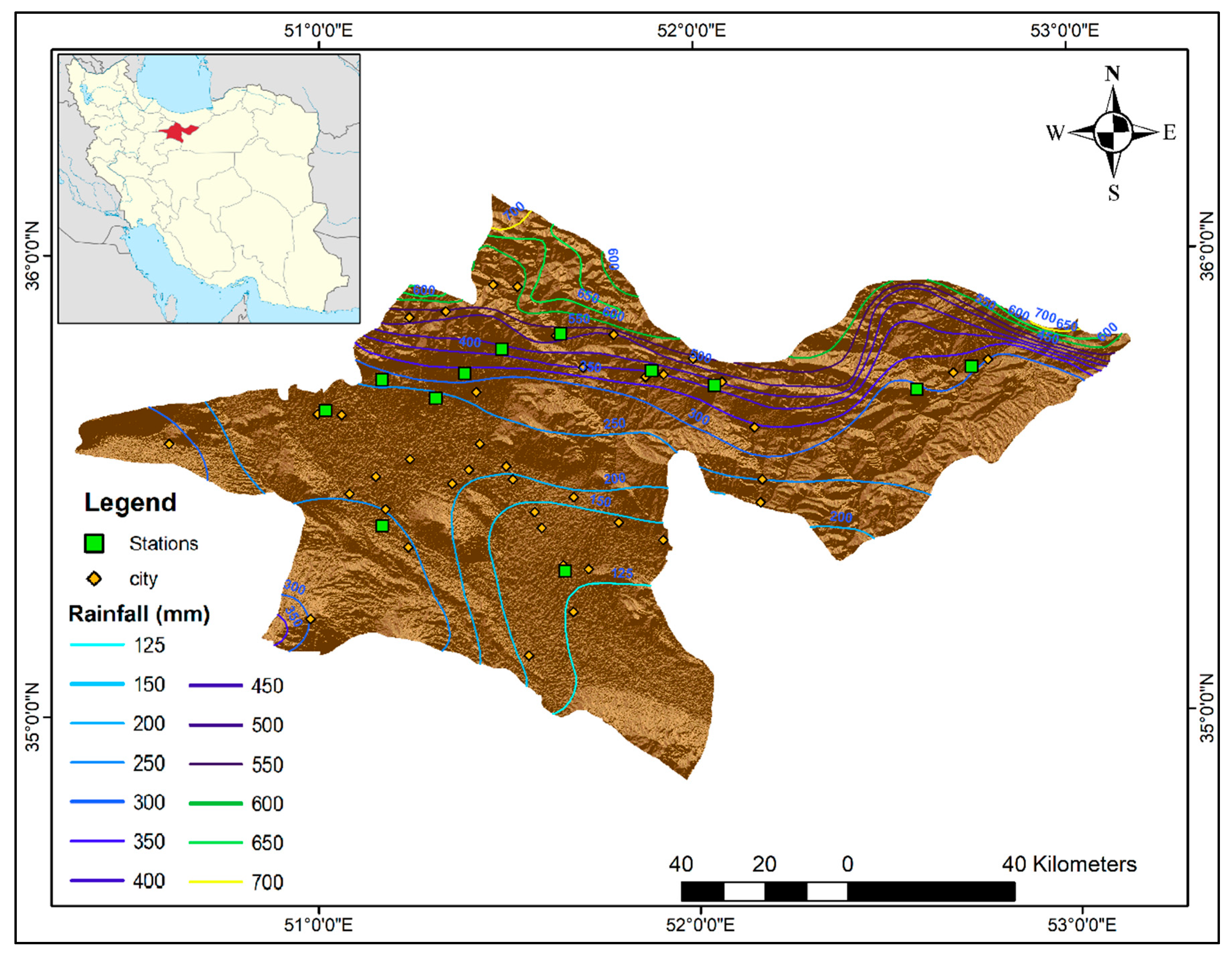
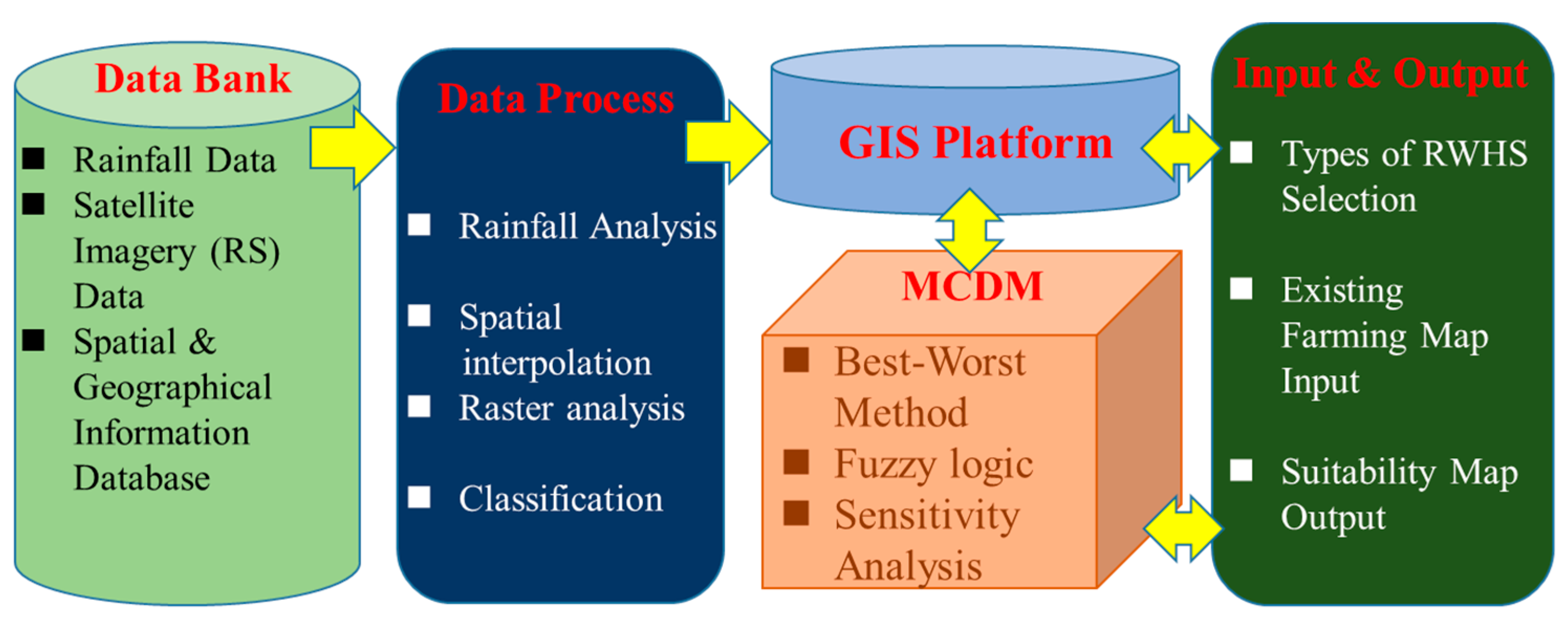

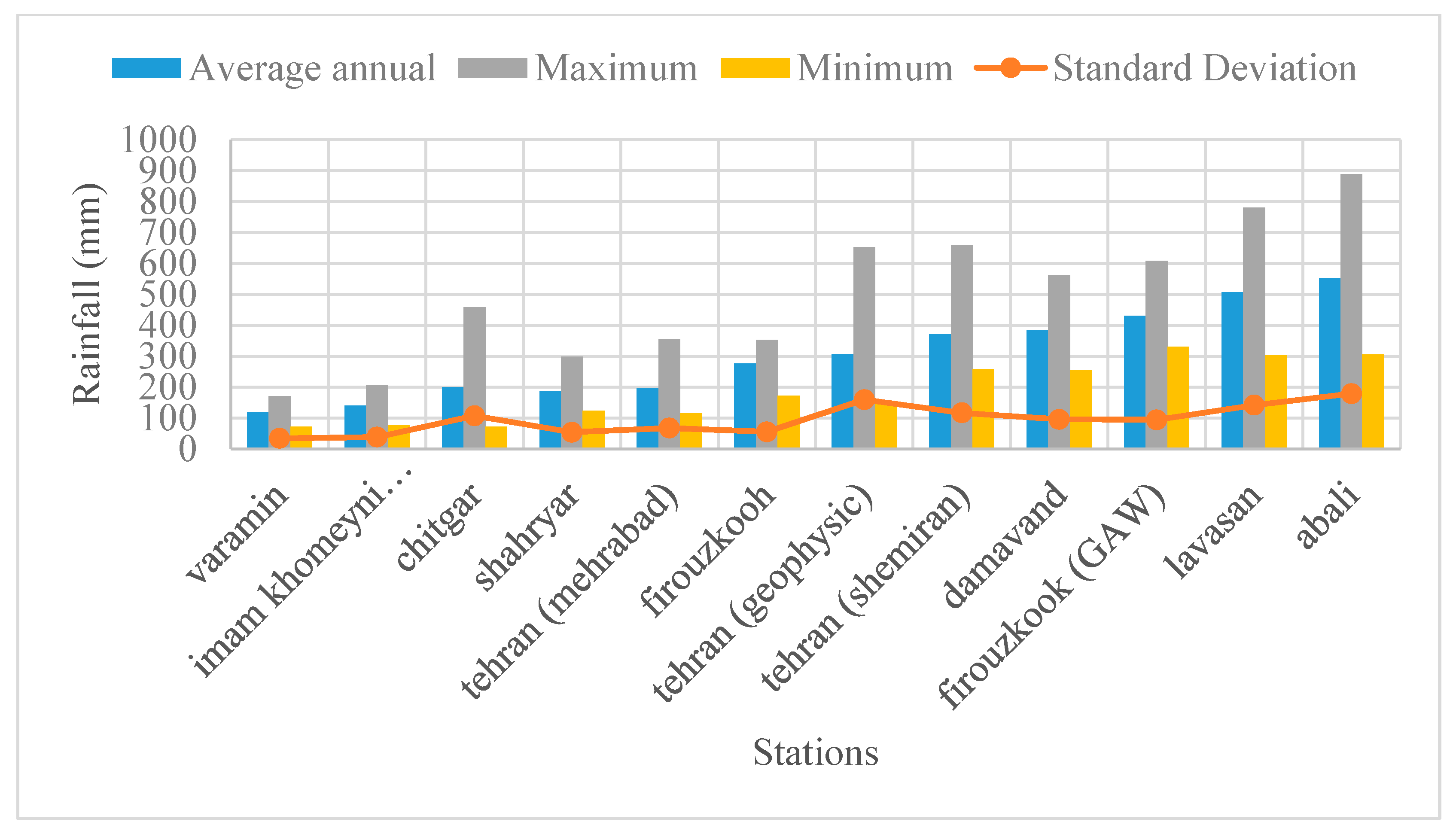








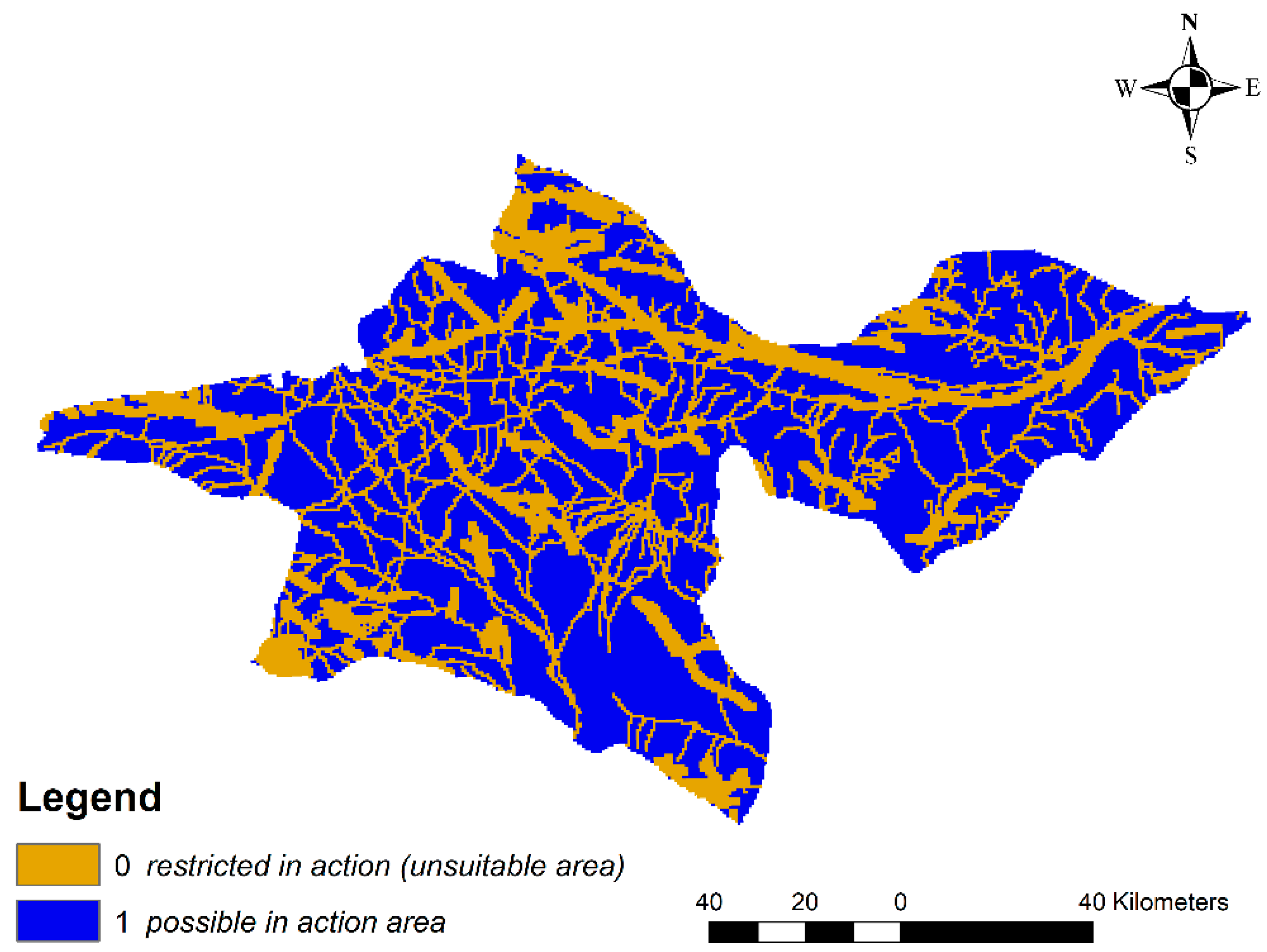
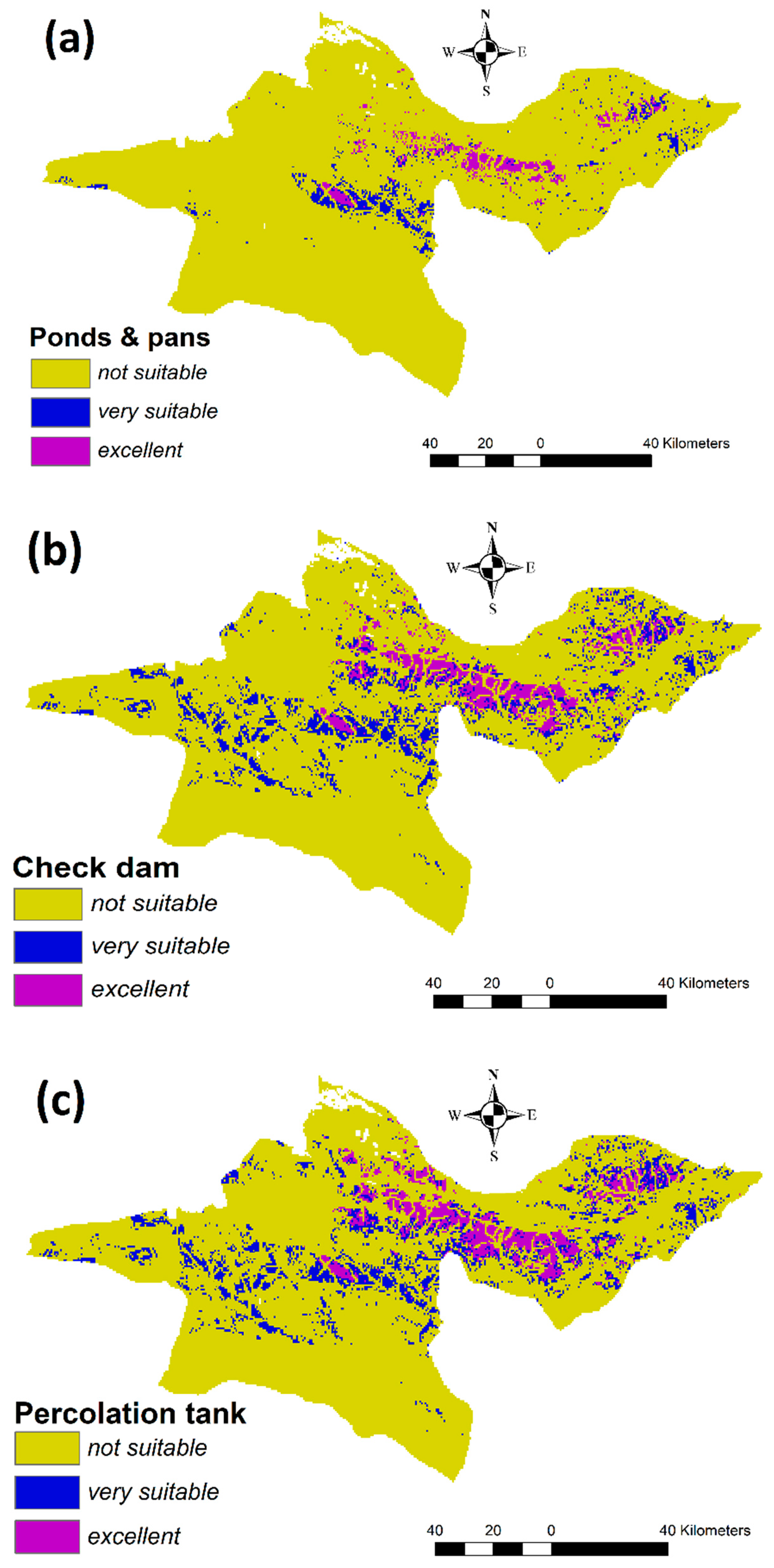
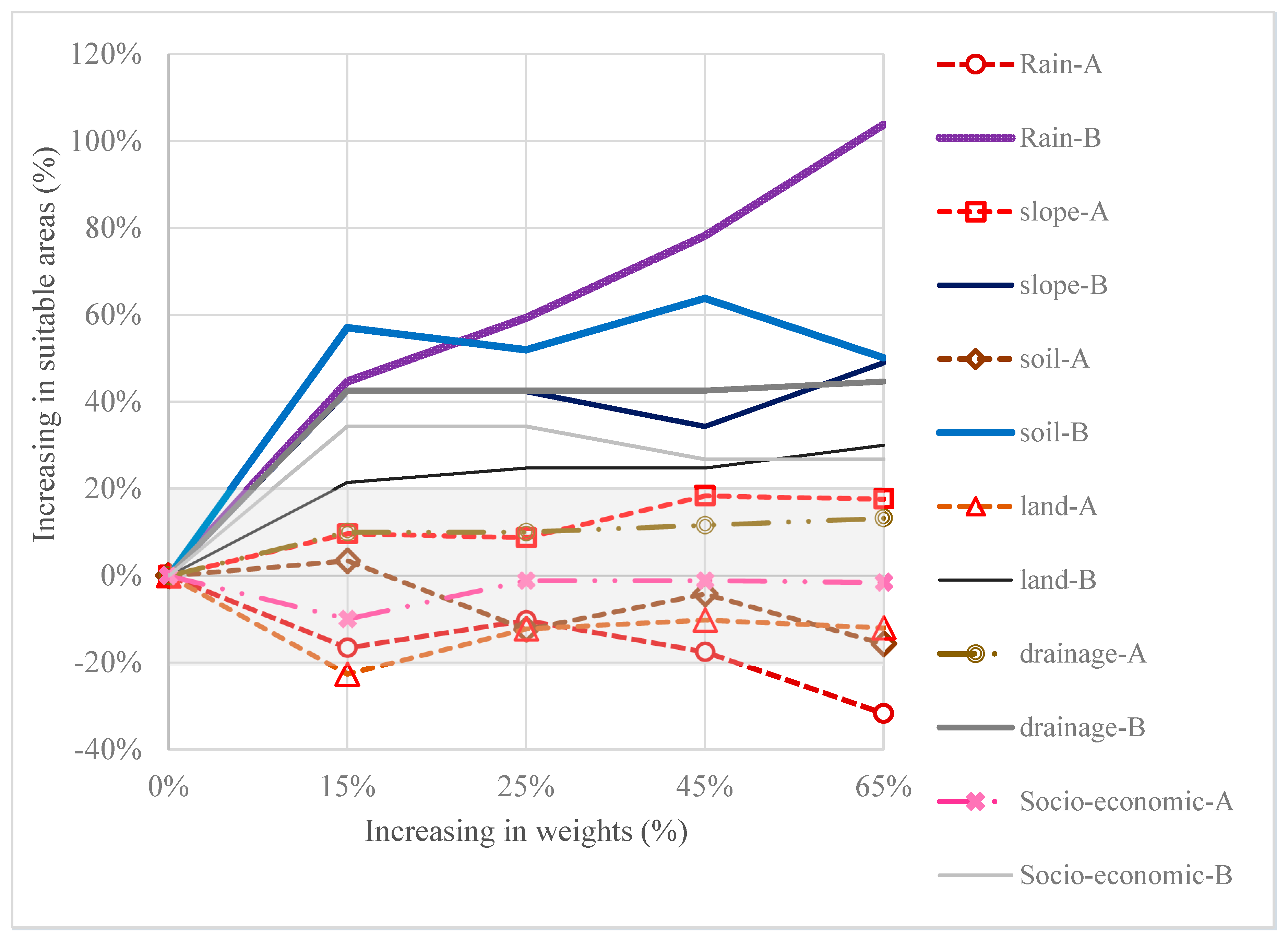
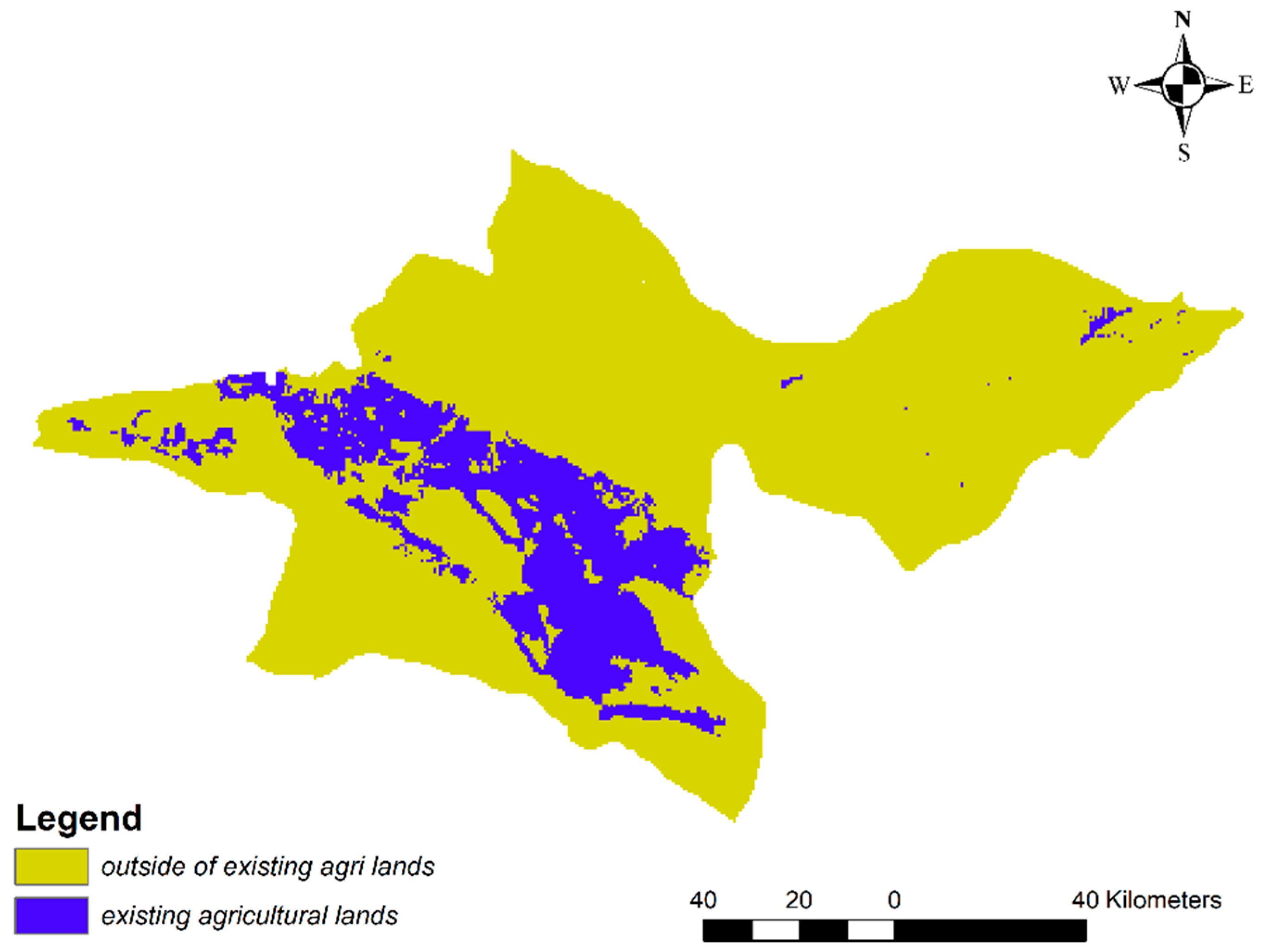
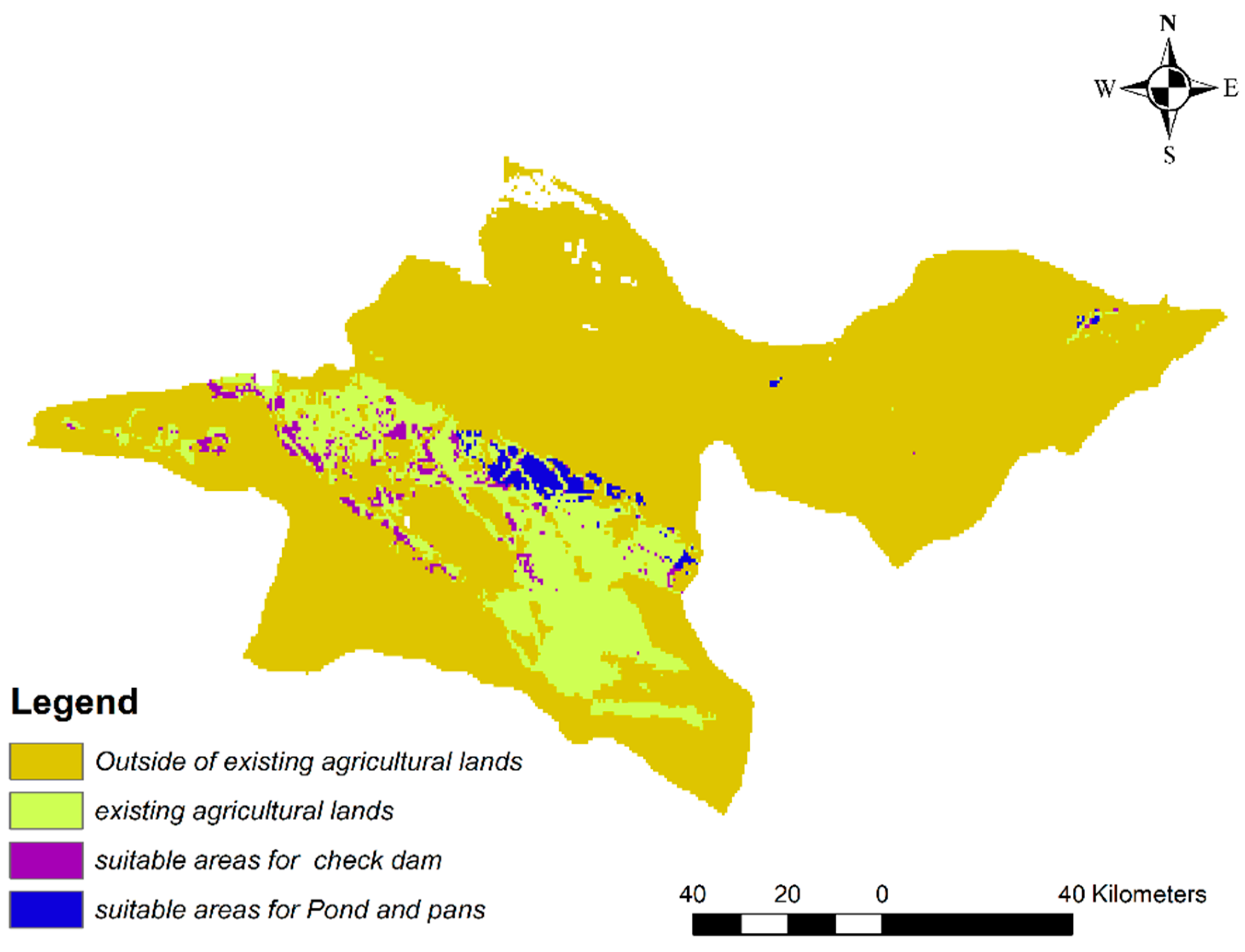


| Intensity of Importance | Definition |
|---|---|
| 1 | Equal importance |
| 3 | Moderate importance of one over another |
| 5 | Essential or strong importance |
| 7 | Very strong importance |
| 9 | Extreme importance |
| 2, 4, 6, 8 | Intermediate values between the two adjacent judgments |
| No. | Layer | Type | Source |
|---|---|---|---|
| 1 | Digital elevation model DEM (30 m) | Raster (the max elevation of the study area 4325.8 m and min elevation 758.28 m) | The United States Geological Survey (USGS) earth explorer 1 |
| 2 | Stations | Vector, the shapefile created in ArcGIS based on the Excel File) | IRIMO |
| 3 | Annual rainfall map with 70% Probability of Exceedance | Rainfall data (Excel File) analyzed probabilistic and then assigned to station points coordinate and finally spatially interpolated to raster format | As a result of Monte Carlo simulation derived by authors |
| 4 | Slope | Raster | Was generated based on ASTER DEM |
| 5 | Land use/cover | Vector | Geographic data center 2 |
| 6 | Soil texture | Raster, Soil tissue map at a depth of 60 cm in Tehran province, which has been prepared using soil profile data of FAO databases. It consists of three layers (percentage of silt, clay and sand) obtained using the soil texture triangle based on the USDA classification. | Engineering and computer research data center 3 |
| 7 | Drainage network | Vector | Geographic data center 2 |
| 8 | Basin/sub basin | Vector | Geographic data center2 |
| 9 | River | Vector | Geographic data center 2 |
| 10 | Road and railway | Vector | Geographic data center 2 |
| 11 | Fault | Vector | Geographic data center 2 |
| 12 | City | Vector | Geographic data center 2 |
| Parameter | 1 | 2 | 3 | 4 | 5 |
|---|---|---|---|---|---|
| Rainfall | 0–100 | 100–200 | 200–300 | 300–400 | 400–600 |
| Slope (%) | >20 | 10–20 | 5–10 | 3–5 | 0–3 |
| Land use/cover | Water body—urban—desert | Rock, Miscellaneous-medium | Poor range-bare land-wood land, | Midrange—mix, agriculture | Afforest-garden-agriculture—High quality range |
| Soil type | Sandy loam | loam | Silt loam | Sandy clay loam | Clay loam, silty clay loam |
| Drainage density (km/km2) | 0–0.17 | 0.18–0.21 | 0.22–0.26 | 0.27–0.29 | 0.3–0.33 |
| Distance to roads, rivers and cities (m) | ≥2000 | ≥1500, <2000 | ≥1000, <1500 | ≥500, <1000 | ≤500 |
| Distance to faults (m) | >1000, <2000 | ≥2000, <3000 | ≥3000, <4000 | ≥4000, <5000 | >5000 |
| Factor | Limitation | Value |
|---|---|---|
| Distance to road | >250 | 1 |
| ≤250 | 0 | |
| Distance to river | >100 | 1 |
| ≤100 | 0 | |
| Distance to city | >250 | 1 |
| ≤250 | 0 | |
| Distance to fault | >1000 | 1 |
| ≤1000 | 0 |
| RWH Technique | Rainfall | Slope (%) | Soil Type | Land Use/Cover |
|---|---|---|---|---|
| Pond and pans | >200 | <5 | Sandy clay loam, silty loam | Ranges, farmlands, pastures, bare lands, woodlands, plain vegetation |
| Check dams | <1000 | <15 | Sandy clay loam | Rivers, ranges, farmlands, pastures, bare lands, rock protrusions |
| Percolation tank | <1000 | <10 | Silt loam, clay loam | Ranges, farmlands, pastures, bare lands, rock protrusions |
© 2020 by the authors. Licensee MDPI, Basel, Switzerland. This article is an open access article distributed under the terms and conditions of the Creative Commons Attribution (CC BY) license (http://creativecommons.org/licenses/by/4.0/).
Share and Cite
Aghaloo, K.; Chiu, Y.-R. Identifying Optimal Sites for a Rainwater-Harvesting Agricultural Scheme in Iran Using the Best-Worst Method and Fuzzy Logic in a GIS-Based Decision Support System. Water 2020, 12, 1913. https://doi.org/10.3390/w12071913
Aghaloo K, Chiu Y-R. Identifying Optimal Sites for a Rainwater-Harvesting Agricultural Scheme in Iran Using the Best-Worst Method and Fuzzy Logic in a GIS-Based Decision Support System. Water. 2020; 12(7):1913. https://doi.org/10.3390/w12071913
Chicago/Turabian StyleAghaloo, Kamaleddin, and Yie-Ru Chiu. 2020. "Identifying Optimal Sites for a Rainwater-Harvesting Agricultural Scheme in Iran Using the Best-Worst Method and Fuzzy Logic in a GIS-Based Decision Support System" Water 12, no. 7: 1913. https://doi.org/10.3390/w12071913
APA StyleAghaloo, K., & Chiu, Y.-R. (2020). Identifying Optimal Sites for a Rainwater-Harvesting Agricultural Scheme in Iran Using the Best-Worst Method and Fuzzy Logic in a GIS-Based Decision Support System. Water, 12(7), 1913. https://doi.org/10.3390/w12071913




